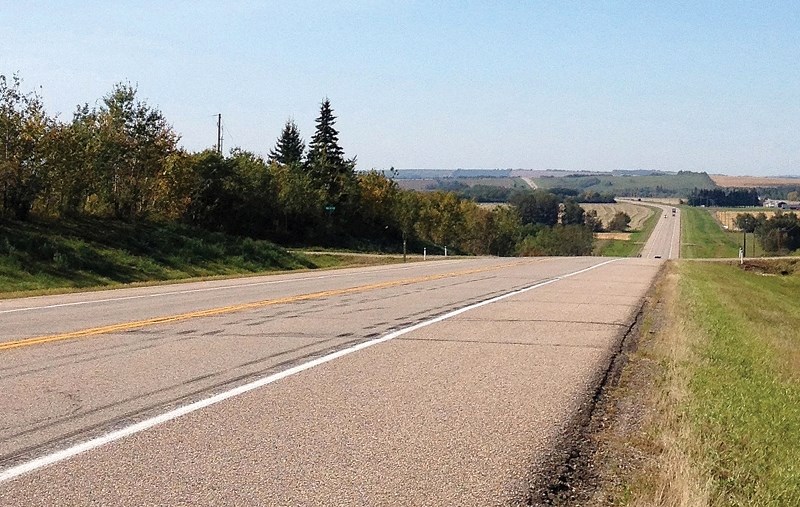The unsafe, deteriorating condition of Highway 28 will soon be brought back to the forefront, as Alberta HUB will be conducting an in-depth look into the province's transportation system.
The study, which will involve surveying industry and government, will highlight the need for investment into infrastructure in northeastern Alberta, according to Alberta HUB's Executive Director Bob Bezpalko.
“Our project is about getting the numbers to supply back to the government on what is happening (transportation-wise), as well as enticing investors to look at investing in our region,” said Bezpalko.
Alberta HUB, officially known as the Regional Economic Development Alliance (REDA) of Northeast Alberta, is an alliance of communities, colleges, business and industry that conveys the best of what the region offers.
“Sometimes people forget what we have and why people go to certain communities. It is our job to remind them,” said Bezpalko.
The region REDA looks after is a vast one consisting of Lac La Biche County, Smoky Lake County, Lamont County, Two Hills County, the County of Minburn, St. Paul County and the Municipal District of Bonnyville.
Every single road, highway and railway that runs through this region will be highly scrutinized during this transportation project as those with Alberta HUB hope to get a clear, in-depth picture of how the province's transportation system works.
Highway 28, Highway 41 and Highway 55 as well as secondary Highway's 663, 897 and 893 are just a handful of roads Bezpalko mentioned would be looked at.
“How do our highways, airports and rail play into the development of oil and gas? There are a lot of loading facilities being developed,” said Bezpalko. “When we start it off we will be talking with industry as well as major companies like B&R Eckels and asking them to identify the needs they are seeing.”
While the roads in the region have slowed down do to the number of jobs lost across the board in the oil industry it doesn't mean that the vehicles that use the road aren't important to the local economy.
The majority of what travels in and out of the MD of Bonnyville comes via highway, whether that is tourists, or oil and gas tankers on their way to a local site, there is still important traffic moving in the region and the Alberta HUB wants the data.
“Transportation always has been a major concern for all of our municipalities,” said Bezpalko. “Now it is about getting the facts and figures, what is happening and the industry development and how everything ties together.”
It's no secret that many in northeast Alberta have been voicing their displeasure over the ever-deteriorating state of Highway 28. Every municipal official that has been in power in Bonnyville, Cold Lake and the MD of Bonnyville has had much to say about the local road, which is a main route to get to and from the city.
Months after getting elected as the new MLA for Bonnyville—Cold Lake, Scott Cyr stood up in the Legislature and voiced his concerns over the need for improvements on the local highway.
“I truly believe Highway 28 is the key, critical artery of our riding. It's one of the worst roads in the entire province and it's time something was done to change that,” said Cyr.
“Right now, there are a heck of a lot of residents that do not use Highway 28, and it's not just people from the Bonnyville – Cold Lake riding avoiding it… People from the Athabasca region and the Lac La Biche – St. Paul riding are choosing not to drive the road too,” Cyr said. “Even though it's the shortest, most direct route into Edmonton, people are avoiding it. That's how bad the road is.”
According to Alberta Transportation another 5,100 kilometres of Alberta's roads went from average to poor condition in 2014. Across the province, roughly 18 per cent of the roads are considered poor.
The Alberta HUB transportation study will take a look at the local roads; quantify their states and safety needs and draw up what should to be done to keep the province's vital transportation system intact.
“Highway 28 is a main east-west corridor and has to be given serious consideration for upgrades,” said Bezpalko.
Bonnyville Mayor Gene Sobolewski has been saying for a while that he would like to see Highway 28 twinned from Cold Lake to Edmonton.
“All we've wanted to see (from the province) is for them to do something to improve the safety and overall drivability of that highway. It's a busy corridor and in it's current state (poses a safety risk) to our residents.”
City of Cold Lake Mayor Craig Copeland has called it Alberta's “forgotten highway,” as the road seems to be left out of funding time and time again.
The PC governments 2015 budget had allocated $43-million to upgrade a 25-kilometre section of Highway 28 north of Gibbons to north of Highway 827. That once promised funding is now up-in-the-air as the province has since moved from a PC government to an NDP government.
Bezpalko says the local highway is also used by people from the region travelling to and from hospitals, with some people coming to Cold Lake and Bonnyville and others making the trek down to Edmonton.
The Alberta HUB's project will be identifying all of the many different people use Highway 28 and all of the other roads throughout the region.
The hope is that the study and final report will be completed over the course of the next 12 to 16 months and then presented to government.
“It involves a lot of interviews and gather information,” said Bezpalko. “I know the transport companies have been very open and plan to share information with us.”



